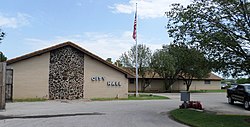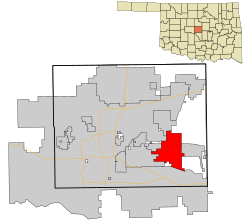Choctaw, Oklahoma | |
|---|---|
 Choctaw City Hall | |
| Motto(s): "Celebrating the Past, Enjoying the Present, & Preparing for the Future." | |
 Location in Oklahoma County and the state of Oklahoma | |
| Coordinates: 35°28′49″N 97°16′00″W / 35.48028°N 97.26667°W | |
| Country | United States |
| State | Oklahoma |
| County | Oklahoma |
| Area | |
| • Total | 27.16 sq mi (70.34 km2) |
| • Land | 27.12 sq mi (70.25 km2) |
| • Water | 0.04 sq mi (0.09 km2) |
| Elevation | 1,155 ft (352 m) |
| Population (2020) | |
| • Total | 12,182 |
| • Density | 449.14/sq mi (173.42/km2) |
| Time zone | UTC-6 (Central (CST)) |
| • Summer (DST) | UTC-5 (CDT) |
| ZIP code | 73020 |
| Area code | 405 |
| FIPS code | 40-14200[3] |
| GNIS feature ID | 2409457[2] |
| Website | http://www.choctawcity.org |
Choctaw is a city in Oklahoma County, Oklahoma, United States, with a population of 12,182 at the 2020 census, a 9.3% increase from 2010. It is the oldest chartered town in Oklahoma Territory.[4] The city is located approximately 10 miles (16.1 km) east of Oklahoma City and is part of the Oklahoma City metropolitan area.
Choctaw became a community in 1890, but was not given actual status as a town until 1893 when a territorial governor was appointed for Oklahoma. It officially celebrated its 100th anniversary in 1993.[5] In 1950, Choctaw was in an agricultural area. It had a population of 355 in that year.[6] Despite its name, the town has no cultural, historical or governmental ties to the Choctaw Nation of Oklahoma. The tribal headquarters and casino are located in the southeastern part of the state in Durant, Oklahoma, and the Choctaw Capitol Building and annual Labor Day Festival are in Tuskahoma, Oklahoma.
Before Choctaw was chartered, the area included a part of William McClure's 7C Ranch and was known for a trading post and a camping spot near a spring.[7]
A community emerged on the east 80 acres (32 ha) of land John S. Muzzy claimed in the 1889 land run and received a postal designation in early 1890.[7]
The town incorporated in April 1904. When Oklahoma became a state in 1907, the town had 230 residents, four churches, a school, a bank, a newspaper and telephone service. By 1909, the town had three gins. The population grew very little during the Great Depression.[7]
- ^ "ArcGIS REST Services Directory". United States Census Bureau. Retrieved September 20, 2022.
- ^ a b U.S. Geological Survey Geographic Names Information System: Choctaw, Oklahoma
- ^ "U.S. Census website". United States Census Bureau. Retrieved January 31, 2008.
- ^ "Choctaw (town) | The Encyclopedia of Oklahoma History and Culture". www.okhistory.org. Retrieved October 7, 2021.
- ^ City of Choctaw website Archived December 31, 2008, at the Wayback Machine
- ^ Columbia-Lippincott Gazetteer. (New York: Columbia University Press, 1952) p. 403
- ^ a b c Everett, Dianna. "Choctaw (City)," Encyclopedia of Oklahoma History and Culture, Oklahoma Historical Society, 2009. Accessed March 25, 2015.
